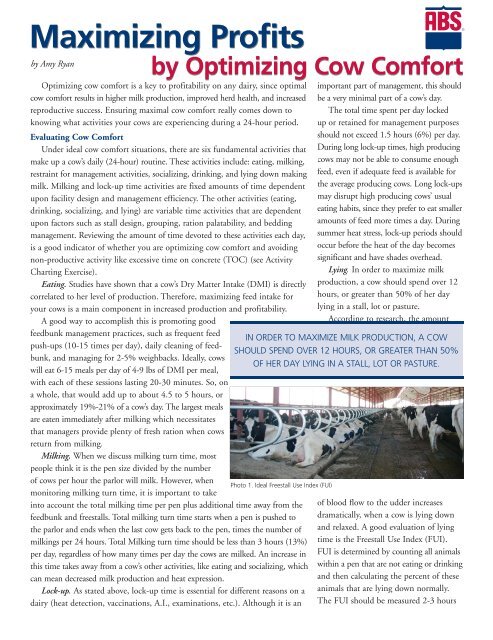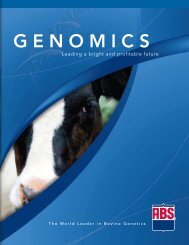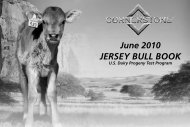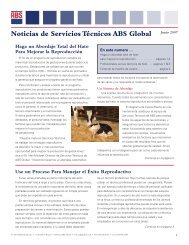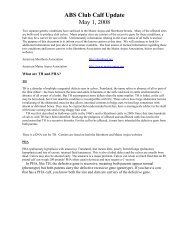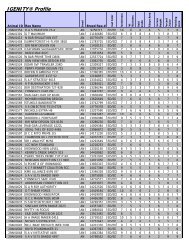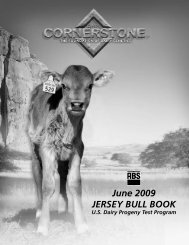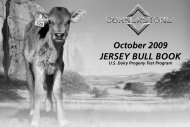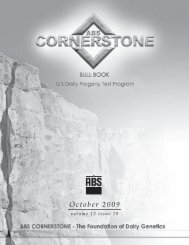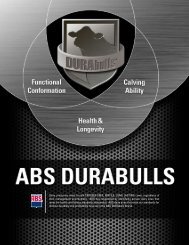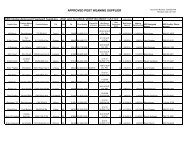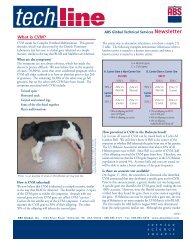Maximizing Profits by Optimizing Cow Comfort - ABS Global
Maximizing Profits by Optimizing Cow Comfort - ABS Global
Maximizing Profits by Optimizing Cow Comfort - ABS Global
Create successful ePaper yourself
Turn your PDF publications into a flip-book with our unique Google optimized e-Paper software.
<strong>Maximizing</strong> <strong>Profits</strong><br />
<strong>by</strong> Amy Ryan<br />
<strong>by</strong> <strong>Optimizing</strong> <strong>Cow</strong> <strong>Comfort</strong><br />
<strong>Optimizing</strong> cow comfort is a key to profitability on any dairy, since optimal<br />
cow comfort results in higher milk production, improved herd health, and increased<br />
reproductive success. Ensuring maximal cow comfort really comes down to<br />
knowing what activities your cows are experiencing during a 24-hour period.<br />
Evaluating <strong>Cow</strong> <strong>Comfort</strong><br />
Under ideal cow comfort situations, there are six fundamental activities that<br />
make up a cow’s daily (24-hour) routine. These activities include: eating, milking,<br />
restraint for management activities, socializing, drinking, and lying down making<br />
milk. Milking and lock-up time activities are fixed amounts of time dependent<br />
upon facility design and management efficiency. The other activities (eating,<br />
drinking, socializing, and lying) are variable time activities that are dependent<br />
upon factors such as stall design, grouping, ration palatability, and bedding<br />
management. Reviewing the amount of time devoted to these activities each day,<br />
is a good indicator of whether you are optimizing cow comfort and avoiding<br />
non-productive activity like excessive time on concrete (TOC) (see Activity<br />
Charting Exercise).<br />
Eating. Studies have shown that a cow’s Dry Matter Intake (DMI) is directly<br />
correlated to her level of production. Therefore, maximizing feed intake for<br />
your cows is a main component in increased production and profitability.<br />
A good way to accomplish this is promoting good<br />
feedbunk management practices, such as frequent feed<br />
push-ups (10-15 times per day), daily cleaning of feedbunk,<br />
and managing for 2-5% weighbacks. Ideally, cows<br />
will eat 6-15 meals per day of 4-9 lbs of DMI per meal,<br />
with each of these sessions lasting 20-30 minutes. So, on<br />
a whole, that would add up to about 4.5 to 5 hours, or<br />
approximately 19%-21% of a cow’s day. The largest meals<br />
are eaten immediately after milking which necessitates<br />
that managers provide plenty of fresh ration when cows<br />
return from milking.<br />
Milking. When we discuss milking turn time, most<br />
people think it is the pen size divided <strong>by</strong> the number<br />
of cows per hour the parlor will milk. However, when<br />
monitoring milking turn time, it is important to take<br />
into account the total milking time per pen plus additional time away from the<br />
feedbunk and freestalls. Total milking turn time starts when a pen is pushed to<br />
the parlor and ends when the last cow gets back to the pen, times the number of<br />
milkings per 24 hours. Total Milking turn time should be less than 3 hours (13%)<br />
per day, regardless of how many times per day the cows are milked. An increase in<br />
this time takes away from a cow’s other activities, like eating and socializing, which<br />
can mean decreased milk production and heat expression.<br />
Lock-up. As stated above, lock-up time is essential for different reasons on a<br />
dairy (heat detection, vaccinations, A.I., examinations, etc.). Although it is an<br />
Photo 1. Ideal Freestall Use Index (FUI)<br />
important part of management, this should<br />
be a very minimal part of a cow’s day.<br />
The total time spent per day locked<br />
up or retained for management purposes<br />
should not exceed 1.5 hours (6%) per day.<br />
During long lock-up times, high producing<br />
cows may not be able to consume enough<br />
feed, even if adequate feed is available for<br />
the average producing cows. Long lock-ups<br />
may disrupt high producing cows’ usual<br />
eating habits, since they prefer to eat smaller<br />
amounts of feed more times a day. During<br />
summer heat stress, lock-up periods should<br />
occur before the heat of the day becomes<br />
significant and have shades overhead.<br />
Lying. In order to maximize milk<br />
production, a cow should spend over 12<br />
hours, or greater than 50% of her day<br />
lying in a stall, lot or pasture.<br />
According to research, the amount<br />
IN ORDER TO MAXIMIZE MILK PRODUCTION, A COW<br />
SHOULD SPEND OVER 12 HOURS, OR GREATER THAN 50%<br />
OF HER DAY LYING IN A STALL, LOT OR PASTURE.<br />
of blood flow to the udder increases<br />
dramatically, when a cow is lying down<br />
and relaxed. A good evaluation of lying<br />
time is the Freestall Use Index (FUI).<br />
FUI is determined <strong>by</strong> counting all animals<br />
within a pen that are not eating or drinking<br />
and then calculating the percent of these<br />
animals that are lying down normally.<br />
The FUI should be measured 2-3 hours
after milking time. Optimal cow comfort<br />
will result in greater than 90% Freestall<br />
Use Index, which is depicted in photo<br />
1. Additionally, at least 50% or more of<br />
lying cows, should be chewing their cud.<br />
As more and more modern dairies are going<br />
to a total confinement design, ability to lie<br />
cows down will have a big impact on cow<br />
longevity, foot health, and overall profitability.<br />
Socializing. In general, socializing<br />
refers to the amount of time that a cow<br />
spends walking around, or interacting<br />
with other animals around her. This<br />
includes grooming, exercising, licking,<br />
but most importantly, expression of heat.<br />
This aspect of a cow’s day may be largely<br />
influenced <strong>by</strong> cow health, environment,<br />
grouping, and time allowed <strong>by</strong> other<br />
activities. On average, a cow spends about<br />
1.5 hours (6%) of her day socializing.<br />
Drinking. Water consumption is a<br />
crucial component to high milk production.<br />
A typical cow should spend 1 hour or 3<br />
percent of her day consuming water.<br />
A high producing cow will drink 30-40<br />
gallons of water per day, which equals<br />
three to four pounds of water per 1 pound<br />
of milk she produces. In order to maintain<br />
this level of consumption, watertanks<br />
should be located in 2-4 sites per pen<br />
and cleaned once per day. There should<br />
be about 3 inches linear space allowed<br />
per cow or one space for 10 animals<br />
when using "hole" type water devices.<br />
<strong>Optimizing</strong> <strong>Cow</strong> Activity<br />
Evaluating your herd’s cow comfort<br />
and identifying problems is only the first<br />
step to increased profits. Finding solutions<br />
and eliminating bottlenecks is the<br />
next phase in successful cow comfort.<br />
Here are a couple different ways to keep<br />
cows off their feet and making milk.<br />
• Decreasing Milking Turn Time<br />
–<br />
This may involve improved parlor<br />
routines that result in decreased unit<br />
on time, shutting down sprinkler pens,<br />
or reducing pen sizes.<br />
• Lock-up times – Studies have shown that unless exceeding 4 hours per day, this is<br />
not a huge bottleneck on most dairies. According to research, the exception<br />
would be if animals become heat stressed while being locked. (see references)<br />
• Improve Freestall Use Index<br />
– If FUI is less than 90% on your dairy, it likely<br />
represents your largest opportunity to correct excessive TOC. Why aren’t<br />
your cows using your freestalls? The two most common reasons are lack of<br />
lunge space or bedding surfaces that are compacted or uncomfortable to lie<br />
Photo 2. Neck rail too low, or inadequate lunge space<br />
on. If using brisket boards, they need to be positioned 66-68 inches from the<br />
rear curb of the stall, placed at a 45-60 degree angle, and not be higher than<br />
4 inches above the bedding surface. Excessive cows standing half in stalls may<br />
be due to low neck rails or inadequate lunge space (see photo 2). Neck rails<br />
should be positioned, 46-48 inches above the bedding height, and should be<br />
placed 60-66 inches from the rear of the curb.<br />
• Install Rubber Belting or Mats –<br />
Many of today’s dairymen are exploring the<br />
use of rubber belting and mats in their facilities.<br />
According to Dr. Neil Michael, Director of Technical Services at <strong>ABS</strong>,<br />
rubber belting seems to work well in return and transfer lanes (photo 3),<br />
while the commercial, softer rubber mats may work better in the feeding<br />
lanes (photo 4). "I believe that rubber mats are key for high producing cows<br />
in today’s commercial dairy operations to reduce time on concrete," says,<br />
Michael. "I know this an expensive recommendation, but so are cows that<br />
can’t get to the feedbunk or have delayed conception due to lameness." He<br />
also mentions that people need to be careful when purchasing conveyor belting,<br />
because some types are harder than others, depending on age, and it’s use<br />
prior to being used in the dairy.<br />
As for commercially<br />
available rubber mats, they<br />
are an increased cost, but<br />
many dairies are choosing<br />
this avenue because they<br />
are thicker than conveyor<br />
belting, and provide more<br />
cushion and shock absorption.<br />
Tim Dewey, herd<br />
manager of Cimarron<br />
Dairy in Cimarron, Kan.,<br />
Photo 3. Rubber belting in transfer lanes
installed these rubber mats in his 8,000-cow dairy six months ago, and is<br />
extremely pleased with the results. "We put the rubber mats in half of the<br />
holding pen, in the parlor itself, in the parlor exit lanes, and in the housing<br />
pens of our freestall facility to help decrease wear and tear on our cows’<br />
feet," says Dewey. "Not only has it improved our feet condition, I believe<br />
we are seeing better conception rate, due to the increased cow comfort."<br />
Plus the mats have really paid for themselves. "Our cull rate due to foot<br />
problems has decreased 12% since we installed the mats. That alone has<br />
paid for the investment," notes Dewey.<br />
<strong>Comfort</strong>able, Profitable <strong>Cow</strong>s<br />
Ensuring cow comfort on your dairy is key to profitability, whether it’s<br />
through higher milk production or improved pregnancy production. Using<br />
fundamental activity times to assess cow comfort can help you detect problems,<br />
and then improve milking turn times, freestall use, or consider rubber matting<br />
Photo 4. Rubber mats in feeding areas<br />
in<br />
key areas of your dairy as needed. All in<br />
all, optimizing essential cow activities<br />
puts money in your pockets.<br />
http://www.vetmed.wsu.edu/courses-jmgay/PM98Student<strong>Comfort</strong>.htm<br />
Specific References:<br />
1. Cermack, J., <strong>Cow</strong> <strong>Comfort</strong> and Lameness-Design of Cubicles, Bovine Practitioner, 1998: 78-83.<br />
2. McFarland, D.F., Gamroth, M. J., and Bucklin, R., Freestall designs with cow comfort in mind. Dairy systems for the 21st century.<br />
Proceedings of the third international dairy housing conference held in Orlando, Florida, USA, 2-5 February 1994: 145-158.<br />
3. Radostits, O.M., Leslie, K.E., and Fetrow, J., Herd Health Food Animal Production Medicine, Saunders, Philadelphia, 1994: 301-330.<br />
4. Albright, J.L., Stouffer, D.K., and Coe, B.L., <strong>Cow</strong> comfort and preference in free stalls with reference to flooring and bedding, Journal of Dairy Science, 1989: 67.<br />
5. Rodenburg, J., House, H.K., Anderson, N.G., and Bucklin, R., Free stall base and bedding materials: Effect on cow comfort, Dairy systems for<br />
the 21st century. Proceedings of the third international dairy housing conference held in Orlando, Florida, USA, 2-5 February 1994: 154-164.<br />
6. Shipka, M.P., C.W. Arave. 1995. Influence of extended manger lock-up on cow behavior and production factors in dairy cattle<br />
management. J. Anim. Scie.73 (Suppl.1):310 (Abstr.)<br />
7. Arave, C.W., D. Bolinger, M.P. Shipka, J.L. Albright. 1996. Effect of extended lock-up of lactating cows on milk production, feed intake and behavior.<br />
J. Anim. Sci. 74 (Suppl. 1):43 (Abstr.)<br />
Activity Charting Exercise<br />
Dr. Neil Michael, Director of Technical<br />
Services at <strong>ABS</strong>, has developed the following<br />
spread sheet exercise to help you monitor<br />
the daily activity of your cattle. The<br />
easiest way to incorporate your data into<br />
the spreadsheet is to enter the following for<br />
your herd: dry matter intake, total turn time<br />
per day milking, lock-up time per day and<br />
the estimated free stall use. Once you have<br />
entered this information, the<br />
program can calculate your herd’s activity<br />
chart, and you can compare this to the<br />
breakdowns in an ideal herd (scenario<br />
shown above).<br />
To obtain this spreadsheet, visit the VIP Lounge in the<br />
Technical Service tab of the <strong>ABS</strong> website (www.absglobal.com).<br />
For more details on activity charting, contact your local <strong>ABS</strong><br />
Representative or call the Technical Services department at<br />
1-800-<strong>ABS</strong>-STUD today.<br />
<strong>ABS</strong> <strong>Global</strong>, Inc. • 1525 River Road • DeForest, WI 53532 •(608) 846-3721 • Fax: (608)846-6392 • www.absglobal.com


